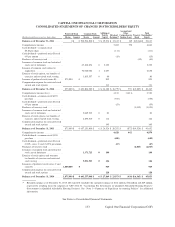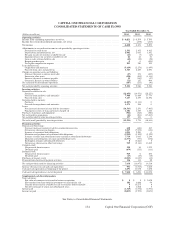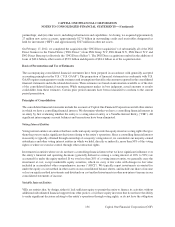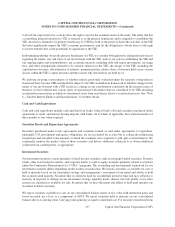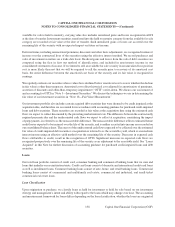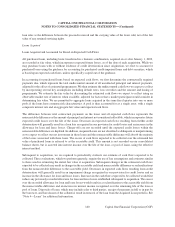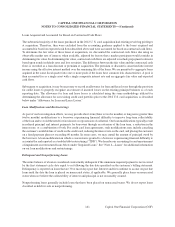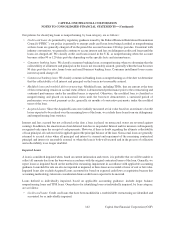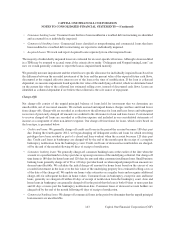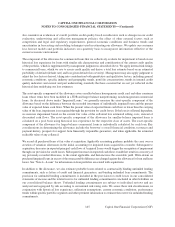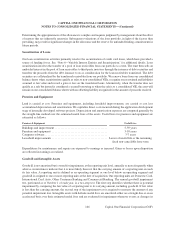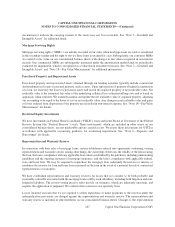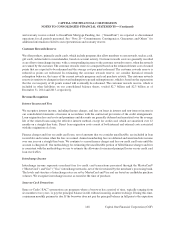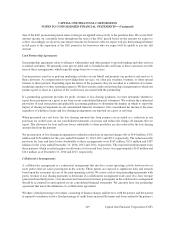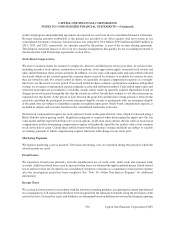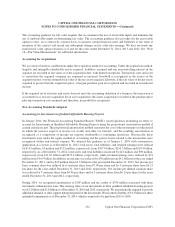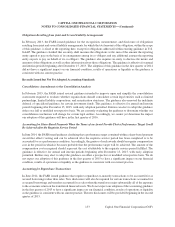Capital One 2014 Annual Report Download - page 165
Download and view the complete annual report
Please find page 165 of the 2014 Capital One annual report below. You can navigate through the pages in the report by either clicking on the pages listed below, or by using the keyword search tool below to find specific information within the annual report.143
•Consumer banking loans: Consumer loans that have been modified in a troubled debt restructuring are identified
and accounted for as individually impaired.
•Commercial banking loans: Commercial loans classified as nonperforming and commercial loans that have
been modified in a troubled debt restructuring are reported as individually impaired.
•Acquired Loans: We track and report Acquired Loans separately from other impaired loans.
The majority of individually impaired loans are evaluated for an asset-specific allowance. Although a loan modified
in a TDR may be returned to accrual status if the criteria above under “Delinquent and Nonperforming Loans” are
met, we would generally continue to report the loan as impaired until maturity.
We generally measure impairment and the related asset-specific allowance for individually impaired loans based on
the difference between the recorded investment of the loan and the present value of the expected future cash flows,
discounted at the original effective interest rate of the loan at the time of modification. If the loan is collateral
dependent, we measure impairment based upon the fair value of the underlying collateral, which we determine based
on the current fair value of the collateral less estimated selling costs, instead of discounted cash flows. Loans are
identified as collateral dependent if we believe that collateral is the sole source of repayment.
Charge-Offs
Net charge-offs consist of the unpaid principal balance of loans held for investment that we determine are
uncollectible, net of recovered amounts. We exclude accrued and unpaid finance charges and fees and fraud losses
from charge-offs. Charge-offs are recorded as a reduction to the allowance for loan and lease losses and subsequent
recoveries of previously charged off amounts are credited to the allowance for loan and lease losses. Costs incurred
to recover charged-off loans are recorded as collection expense and included in our consolidated statements of
income as a component of other non-interest expense. Our charge-off time frame for loans, which varies based on
the loan type, is presented below.
•Credit card loans: We generally charge-off credit card loans in the period the account becomes 180 days past
due. During the fourth quarter 2012, we began charging off delinquent credit card loans for which revolving
privileges have been revoked as part of a closed end loan workout when the account becomes 120 days past
due. Credit card loans in bankruptcy are charged-off by the end of the month upon the receipt of a complete
bankruptcy notification from the bankruptcy court. Credit card loans of deceased account holders are charged-
off by the end of the month following 60 days of receipt of notification.
•Consumer banking loans: We generally charge-off consumer banking loans at the earlier of the date when the
account is a specified number of days past due or upon repossession of the underlying collateral. Our charge-off
time frame is 180 days for home loans and 120 days for auto and other consumer installment loans. Small business
banking loans generally charge off at 90 or 120 days past due based on when unpaid principal loan amounts are
deemed uncollectible. We calculate the initial charge-off amount for home loans based on the excess of our
recorded investment in the loan over the fair value of the underlying property less estimated selling costs as
of the date of the charge-off. We update our home value estimates on a regular basis and recognize additional
charge-offs for subsequent declines in home values. Consumer loans in bankruptcy, except for auto and home
loans, generally are charged-off within 40 days of receipt of notification from the bankruptcy court. Auto and
home loans in bankruptcy are generally charged-off in the period that the loan is both 60 days or more past due
and 60 days or more past the bankruptcy notification date. Consumer loans of deceased account holders are
charged-off by the end of the month following 60 days of receipt of notification.
•Commercial banking loans: We charge-off commercial loans in the period we determine that the unpaid principal
loan amounts are uncollectible.
CAPITAL ONE FINANCIAL CORPORATION
NOTES TO CONSOLIDATED FINANCIAL STATEMENTS—(Continued)
Capital One Financial Corporation (COF)


